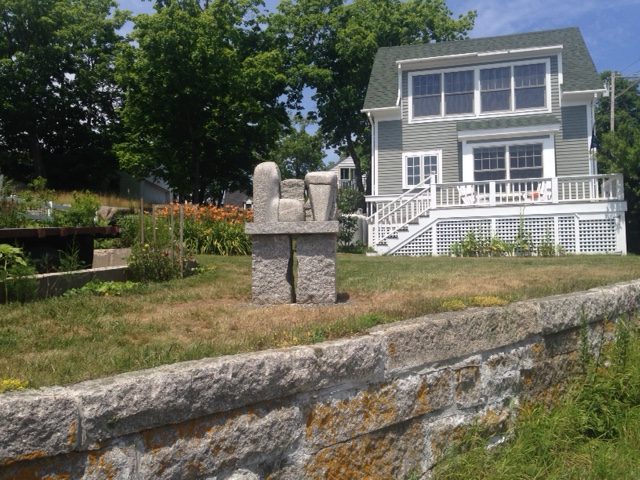Last Tuesday, July 12, the massive granite sculpture named “Two” by its creator, Maine sculptor Roy Patterson, took up its new home on my front lawn. Instantly it looked like it had been here for eons.
 I’m still in a bit of shock at what could have led me to shell out what from my perspective is an astronomical chunk of change for this assemblage of granite blocks. And yet there was something so compellingly right about it—so natural—that I could only keep moving ahead with this decisionless decision that seems to have emerged from some intentionality deeper than my own. So when my friend Lindsay Bowker pressed me a bit further on this point in preparation for an article on its installation she’s cooking up for the local paper, I put my thinking cap on, and this is what I came up with…
I’m still in a bit of shock at what could have led me to shell out what from my perspective is an astronomical chunk of change for this assemblage of granite blocks. And yet there was something so compellingly right about it—so natural—that I could only keep moving ahead with this decisionless decision that seems to have emerged from some intentionality deeper than my own. So when my friend Lindsay Bowker pressed me a bit further on this point in preparation for an article on its installation she’s cooking up for the local paper, I put my thinking cap on, and this is what I came up with…
 ….From the moment I bought the little house on School Street in Stonington, I knew I was placing myself in a very public location. Everything I did here would be on display. That’s the nature of the site.
….From the moment I bought the little house on School Street in Stonington, I knew I was placing myself in a very public location. Everything I did here would be on display. That’s the nature of the site.
 I was also aware that I was assuming a profound gift and responsibility from Michie O’Day, the former owner. Michie is a talented artist and an awesome gardener, and she loved this little house dearly and did the best she could during her decade on watch to bring it along. She adored Stonington—in fact, she would never have left were it not for chronic health issues. Michie and I became friends during the course of the sale and have remained so, and it’s both a privilege and a debt of honor to carry on the vision that she had for this place.
I was also aware that I was assuming a profound gift and responsibility from Michie O’Day, the former owner. Michie is a talented artist and an awesome gardener, and she loved this little house dearly and did the best she could during her decade on watch to bring it along. She adored Stonington—in fact, she would never have left were it not for chronic health issues. Michie and I became friends during the course of the sale and have remained so, and it’s both a privilege and a debt of honor to carry on the vision that she had for this place.
 One of the things that I was able to bring off early in my time here was to buy a swathe of the adjacent property from my next-door neighbors, Phil and Heidi Anderson. That allowed me to secure my view down School Street and to become the owner of that striking, prow-like front corner of the property, sitting high above the intersection of Church and School streets like the bow of a ship.
One of the things that I was able to bring off early in my time here was to buy a swathe of the adjacent property from my next-door neighbors, Phil and Heidi Anderson. That allowed me to secure my view down School Street and to become the owner of that striking, prow-like front corner of the property, sitting high above the intersection of Church and School streets like the bow of a ship.
![IMG_2990[1]](https://wisdomwaypoints.org/wp-content/uploads/2016/07/IMG_29901-e1468937094362-225x300.jpg) I’d long thought that a piece of sculpture might be perfect there: partly because plants don’t grow well on that spot (lucky for me; otherwise I would have immediately succumbed to the temptation to put an apple tree there) and partly because I deeply appreciate fine art as well as the proud heritage and physical beauty of this tiny fishing village I have called home on and off for more than twenty years now. Fine art transforms physical beauty into spiritual beauty, touching deep archetypal currents (at least if it’s good art) without ever being too blatant or ideological about it, without forcing people to see in a certain way. Fine art simply evokes the heart.
I’d long thought that a piece of sculpture might be perfect there: partly because plants don’t grow well on that spot (lucky for me; otherwise I would have immediately succumbed to the temptation to put an apple tree there) and partly because I deeply appreciate fine art as well as the proud heritage and physical beauty of this tiny fishing village I have called home on and off for more than twenty years now. Fine art transforms physical beauty into spiritual beauty, touching deep archetypal currents (at least if it’s good art) without ever being too blatant or ideological about it, without forcing people to see in a certain way. Fine art simply evokes the heart.
The idea of placing Roy Patterson’s sculpture on that site grew on me gradually as I passed by it year after year, season after season, sitting there in the dooryard of the Turtle Gallery in Deer Isle. I never really decided to; it just seemed more and more obvious that the piece would fit perfectly there. It is solid and familiar, built of the very granite blocks and shapes that all the walls up and down School Street are built of, including the one it sits atop. So it dialogues well with the natural world here, and with our local history and heritage. But it has another level of meaning as well, much more subtle, allusive and archetypal.
Roy Patterson calls the piece “Two,” and as its creator, he has his own unique and deep relationship with this sculpture. For him, it speaks of maternal tenderness and nurturance. The “two” are the granite mother and child.
But precisely in the measure that a work of art is genuine and deep, it also graciously receives the interpretations of the beholder. And for me, given my background as an Episcopal priest, this work is quintessentially (though allusively) an altar, and the stone circle sitting on it a host, and its granite solidity reverberates in my spiritual imagination with Teilhard de Chardin and his archetypal “Mass on the World,” offered not in bread and wine, but in human labor and human suffering. To me this sculpture is supremely Teilhardian, bringing together geology, solidity, universality, and an implicit offering of gratitude and petition for our one world, at once hauntingly particular and sweepingly universal.
And so I place this small “altar” at the prow of this property I am stewarding: facing downhill toward the fishermen, quarrymen, and townsfolk who have made our village what it is, all the while allusively affirming that there are dimensions of our common life that go deeper than even civic or public duty. They touch the sacred.
P.S: Post-installation: Well, for the record, it is an absolutely powerful altar! That was clear even as its granite pillars were being swung into place from the boom truck. And now as I stand behind it facing down School Street toward the fishing boats, the islands and ocean stretching beyond, and our one world stretching still “beyonder,” I sense that it is indeed for the offering of The Mass of the World—in whatever physical or imaginal space this ritual may transpire—that this mysteriously beautiful and compelling piece has found its way to me. Whatever else unfolds during the time that TWO and I sojourn together here on the corner of School and Church streets, it has already called me in its quiet and insistent way to a renewed seriousness of commitment to our common humanity, and to our one beautiful and fragile planet, hurtling toward either transfiguration or destruction. Like Teilhard, as I stand every morning before its solid, sheltering pillars, I will send my blessings and prayers out over those shining waters with that same fervent plea with which Teilhard’s Mass reaches its climax: “Lord, make us One!”
“…When you can make TWO become one,” says the Gospel of Thomas….Could that be what it’s all about? Seriously?


Beauty is for everyone. Thank you for sharing this beautiful sculpture with us and your neighborhood.
Beautiful and healing in every way – both the sculpture and your words. I’m writing from Mass General Hosp, where I’m recovering from highly successful surgery. Grace abounding.
Reminds me slightly of Brancusi’s “Kiss”
How is it that the impassive solidity of granite can be so moving?